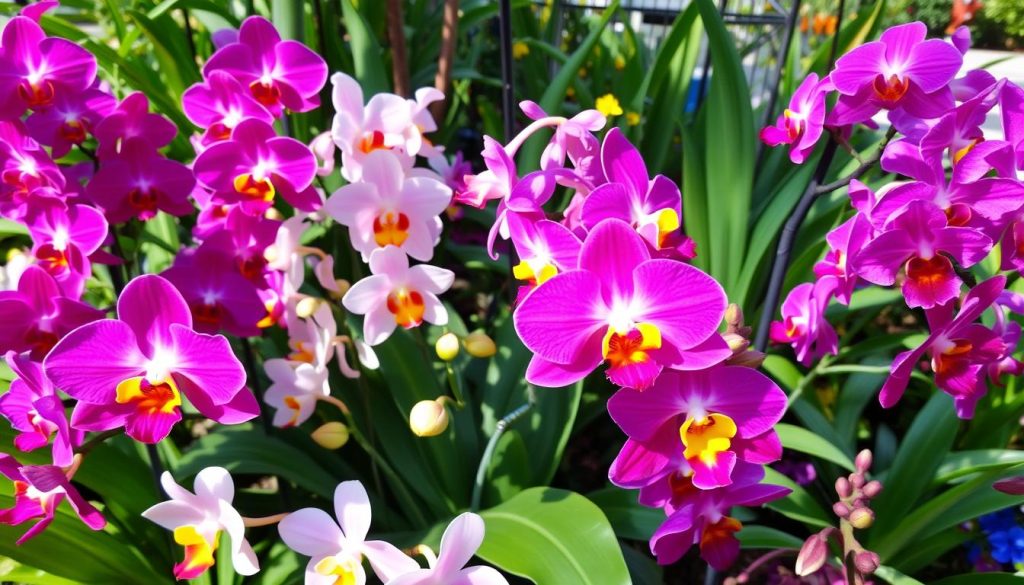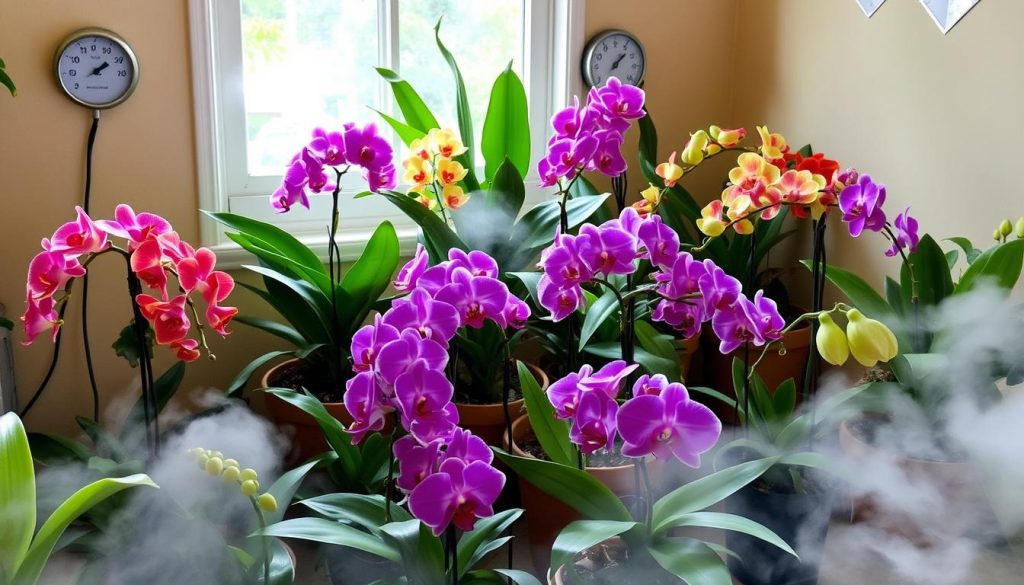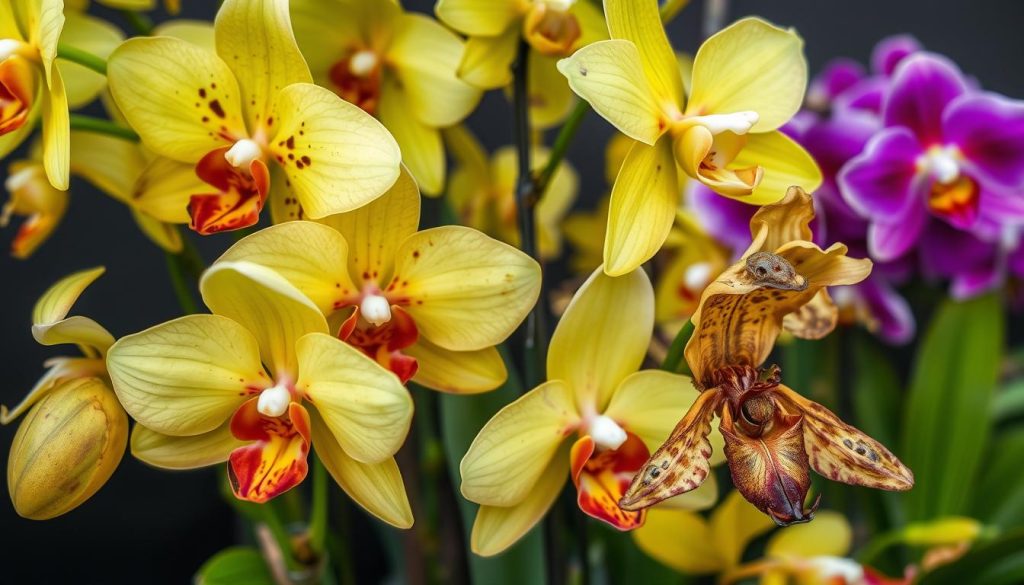Unlock the secrets to growing captivating orchids and turn your home into a lush oasis. This guide is perfect for both seasoned gardeners and new plant lovers. It will teach you how to grow and care for these beautiful flowers.
From learning about the many orchid species to mastering care, this article is your key to enjoying orchids at home.

Key Takeaways
- Explore the fascinating world of over 30,000 orchid species and 200,000 hybrids.
- Discover the unique growing requirements for various orchid varieties, including temperature, humidity, and lighting preferences.
- Learn proper watering, fertilization, and potting techniques to ensure the long-term health and vibrant blooms of your orchids.
- Gain insights into common orchid diseases and prevention methods to keep your plants thriving.
- Unlock the secrets of orchid propagation and repotting to multiply your collection.
Introduction to the Enchanting World of Orchids
Orchids are amazing plants that win the hearts of many. They come in many varieties, each with its own beauty. These plants show us the wonders of nature with their delicate blooms and special ways of growing.
Orchids are known for their complex biology and lovely scents. Some orchids smell like insects or animals to attract pollinators. This shows how orchids have evolved to connect with the natural world.
Orchids can tell us about the health of our ecosystems. Some orchids are very sensitive to changes in their environment. Knowing which orchids are present can help us understand and protect our natural spaces.
Some orchids, like the Singapore Orchid, can live in both wild places and cities. Others, like the ghost orchid, are harder to grow. The ghost orchid’s mystery and special needs have made it a favorite among plant lovers.
Orchids also have deep cultural and symbolic meanings. They can stand for love, beauty, and strength. They even represent the beauty of being vulnerable. The creation of diamond orchids shows how orchids inspire luxury and design.
Exploring orchids reveals their resilience, diversity, and beauty. By learning about different orchids, we can appreciate nature more. We also see how important orchids are to our ecosystems.
Understanding Different Orchid Varieties
The orchid family, Orchidaceae, has over 25,000 types. From Phalaenopsis (moth orchids) to rare species, orchids come in many colors and shapes. Knowing about different orchids helps you pick the right ones for your space and taste.
Popular Indoor Orchid Species
Many orchids are easy to grow indoors. Phalaenopsis orchids, or moth orchids, are a favorite. They bloom in many colors. Other easy-to-grow types include Dendrobiums, Epidendrums, and Oncidiums, each with its own needs.
Rare and Exotic Orchid Types
Some orchids are very rare and hard to find. Types like Aerangis, Ascocenda, and Catasetum are a challenge for growers. But, growing these rare orchids can be very rewarding.
Seasonal Blooming Patterns
Orchid care varies by type and environment. Some orchids, like Laelia and Miltonia, bloom at certain times. Knowing when they bloom helps you care for them better and enjoy their flowers longer.
Essential Growing Conditions for Healthy Orchids
To grow beautiful orchids, you need to know their special needs. These flowers do best in certain conditions that help them stay healthy and bloom well. Let’s look at the key factors for growing orchids successfully.
Light Requirements
Orchids like different amounts of light. Some need bright, indirect sunlight, while others prefer shadier spots. Indoor favorites like Phalaenopsis and Dendrobium do well with plenty of filtered light. The right light is important for their leaves and flowers to thrive.
Temperature and Humidity
Orchids don’t like big temperature changes. They do best in temperatures between 50 and 90 degrees Fahrenheit. Keeping the humidity right, between 40% and 70%, is also vital for these tropical plants.
Watering and Potting
It’s important to water orchids just right. They like their potting mix to dry a bit between waterings. Also, use a special potting mix for orchids to avoid root rot from regular soil.
Fertilization and Nutrients
Feeding orchids the right way is crucial for their health and growth. Use a balanced, orchid-specific fertilizer during the growing season. Cut back on fertilizing when they’re not actively growing.
By knowing and meeting these growing needs, orchid lovers can grow these stunning flowers. They can then enjoy their beauty in homes or gardens.
Light Requirements and Placement Tips
Lighting is key for orchids to grow well and bloom brightly. Knowing about natural and artificial light is important. Let’s look at the basics of light needs and how to place your orchids.
Natural vs Artificial Lighting
Orchids need the right amount of light to grow and bloom. Too little light makes them weak, while too much can harm them. An east-facing window is best, offering bright, indirect light.
For those growing orchids indoors, artificial light can help. Fluorescent bulbs and LED lights have the colors orchids need. When choosing artificial light, consider Color Rendering Index (CRI), Color Temperature (Kelvin), and Photosynthetic Photon Flux Density (PPFD).
Window Orientation Guide
The direction of your windows affects the light your orchids get. South-facing windows get the most sunlight, while north-facing get the least. It’s important to place your orchids right in the window, not too close or too far.
Seasonal Light Adjustments
Orchids need different light levels at different times of the year. In summer, they might need more shade or a less bright spot. In winter, they might need extra light to grow and bloom well.
By understanding light needs and making the right adjustments, you can create the best environment for your orchids. This will help them thrive and show off their beauty.
Watering Techniques and Moisture Management
Proper watering is key for your orchids’ health and life span. Orchids need water differently than most houseplants. Knowing their needs is vital for caring for them well.
Orchids need watering once a week in winter and twice a week in warm, dry weather. They should not go without water for more than two to three weeks. A simple way to water them is with three ice cubes a week, which keeps them hydrated.
Orchids prefer to be a bit dry rather than too wet. Too much water can cause root rot and other problems. The type of potting medium affects how often you need to water. For example, bark or wood chips may need watering every four to 10 days. Sphagnum moss requires watering every seven to 10 days to keep it moist but not too wet.
- Orchids are usually grown in bark chips or moss, not potting soil.
- Watering orchids in the morning is recommended to allow leaves to dry before nightfall.
- Rainwater or tap water without salts is suitable for orchids, and ice cubes can also be used to water them weekly.
- Misting orchids by hand is not recommended; instead, using a humidity tray or humidifier can maintain proper humidity levels.
By understanding orchids’ unique watering needs and using the right techniques, you can help them thrive. They will reward you with beautiful blooms.
Temperature and Humidity Controls for Orchids
Keeping the right temperature and humidity is key for orchids to grow well and bloom. The right environment can make a big difference in your orchid care success.
Optimal Temperature Ranges
Orchids need different temperatures to thrive. Most like daytime temperatures between 70°F and 85°F (21°C and 29°C). At night, they prefer it 10-15°F (5-8°C) cooler. Phalaenopsis orchids, a common indoor type, do best in temperatures from 65°F to 85°F (18°C to 29°C).
Humidity Management Methods
Orchids need high humidity, usually 50-80%, to stay healthy. You can use humidity trays, mist them, or a humidifier to keep moisture right. Also, good air flow is important to avoid fungal problems from too much humidity.
Seasonal Environmental Adjustments
Orchid care changes with the seasons. In summer, you might need to cool and ventilate more. In winter, you might need to heat and humidify more to mimic their natural home. Watching and adjusting the environment is crucial for orchid success.

Knowing the best temperature and humidity for your orchids and adjusting as needed is important. This way, you can create a great environment for these beautiful plants. With the right controls, you’ll enjoy beautiful, long-lasting blooms.
Soil Mediums and Potting Requirements
Growing orchids needs careful attention to soil and potting. They don’t grow well in regular soil. Instead, they thrive in specific materials. This guide will help you choose the right growing medium and potting techniques for your orchids.
Orchid enthusiasts are always looking for the best growing medium. They try everything from tree fern to lava rock, and even sphagnum moss and osmunda. The goal is to find something that lets air to the roots and drains well, mimicking their natural habitat.
Think about your orchid’s root size when picking a potting medium. Seedlings need small particles, while bigger plants need larger ones. Organic materials give nutrients, while inorganic ones ensure air and water flow.
- Organic materials like tropical tree ferns, osmunda ferns, and redwood bark offer a natural, earthy environment for orchids.
- Inorganic materials such as perlite, charcoal, and lava rock provide the necessary drainage and air circulation.
Choosing the right potting medium is key for your orchids’ health. Different types like Phalaenopsis, Cattleya, and Dendrobium need specific soil and potting. By understanding these needs, you can help your orchids grow strong and bloom well.
Don’t forget to repot your orchids every 1-2 years. This keeps the potting medium fresh and your orchids healthy. By paying attention to your orchids’ needs and adjusting your soil and potting, you can make them thrive.
Feeding and Fertilization Schedule
Proper nutrition is key for orchid health and blooming. Knowing the different types of orchid fertilizers is crucial. It’s also important to know how to apply them effectively.
Types of Orchid Fertilizers
Orchids need a balanced mix of nutrients for growth and flowers. Inorganic fertilizers, like the 20-20-20 formula, are a reliable source. Organic options, such as seaweed kelp and fish emulsion, offer a natural choice with a slow release.
Application Methods and Timing
- The best fertilizing routine is “weekly, weakly”. This means applying a diluted solution (1/2 to 1/4 strength) for 3 out of 4 weeks. The 4th week should be a break from fertilizer.
- Orchids in tropical or subtropical climates need fertilizing during the wet season. This is when they grow the most. During the dry season, they don’t need any fertilizer.
- Some orchids, like Maxillaria tenuifolia, need regular fertilization all year. Others, like Coelogyne orchids, shouldn’t be fertilized during their winter sleep.
- Properly fertilized orchids have bigger flowers, strong roots, and shiny, healthy leaves.
It’s important to know what your orchid needs based on its type and growth cycle. By giving the right nutrients at the right time, your orchids can thrive and reach their best.
Common Orchid Diseases and Prevention
Keeping your orchids healthy is key for their beauty and long life. Orchids can get sick from fungi, bacteria, viruses, and pests. Knowing the common diseases and taking steps to prevent them can help your orchids stay healthy.
Bacterial Soft & Brown Rot is a serious disease caused by Pectobacterium. It can destroy an orchid in just 2-3 days. Bacterial Brown Spot, caused by Pseudomonas cattleya, often hits Phalaenopsis orchids.
Fungal diseases like Black Rot, Fusarium Wilt, and Southern Blight can harm orchids. These diseases spread fast in warm, humid places. They can kill plants that get too sick.
- Foliar blights, leaf spots, fungal rots, and flower blights are common orchid diseases.
- Too much moisture on leaves and flowers, and poor soil drainage, can lead to diseases.
- Good sanitation and cultural changes can help prevent diseases.
To fight orchid diseases, spot symptoms early, remove infected parts, and treat with fungicides or bactericides. Being careful and proactive can keep your orchids healthy and blooming for years.

Propagation and Repotting Guidelines
Orchid lovers have two main ways to grow their plants: division and vegetative propagation. Knowing these methods is key to keeping your orchids healthy and vibrant.
Division Methods
Sympodial orchids, like cattleyas and oncidiums, can be split during repotting. This means separating the plant into sections, each with roots and pseudobulbs. Dividing a mature orchid can make it grow new and strong.
To split an orchid, cut the rhizome between the pseudobulbs. Make sure each part has enough healthy roots and growth points.
Repotting Timeline
Timing is crucial when repotting orchids. Common types, like phalaenopsis, need repotting every one to three years. This is best done after they finish blooming.
Repotting helps the plant grow new roots and refreshes the soil. It’s also needed when the plant outgrows its pot or the soil breaks down.
Good repotting practices, like checking roots and choosing the right soil, are vital. By following these tips, your orchids will flourish and bring you joy with their beautiful flowers.
Seasonal Care and Maintenance Tips
As the seasons change, so do the needs of your orchids. You’ll need to adjust watering and light exposure. Knowing what your orchids need each season is crucial for their health and beauty.
Winter Orchid Care
In winter, orchids need a balance of temperature, light, and moisture. Keep their temperature between 50°F and 80°F. This helps them grow and bloom.
Don’t let your orchids get frost or cold for too long. It can hurt their growth. If it gets too cold, move them indoors or use a heater.
Lighting is also important in winter. Most orchids need 12-14 hours of light a day to bloom. If it’s too dark, use artificial light to help.
Spring Orchid Care
- As spring comes, water and fertilize more to help them grow and bloom.
- Check for new roots. This is the best time to repot and divide if needed.
- Clean your orchids gently with a soft cloth and a mix of milk or lemon juice. It keeps them looking good.
- Use stakes to support the flower spikes. It makes the blooms stand out.
By paying attention to your orchids’ seasonal needs, they’ll thrive. They’ll reward you with beautiful colors and scents all year. Enjoy the journey of caring for these magical plants.
Growing Orchids: Advanced Techniques
If you love growing orchids, you might want to learn more. There are advanced techniques to help you grow these beautiful flowers like a pro. You can learn about hybridization and creating special growing spaces in this section.
Hybridization lets you mix different orchids to make new ones. You pick parents with traits you like, like color or smell. It’s a fun way to make unique orchids, but it takes skill and knowledge.
Creating special growing spaces is another cool technique. You can build a greenhouse or a humidity-controlled cabinet. These spaces mimic the orchids’ natural homes, helping them grow and bloom better.
- Mastering the art of hybridization to create unique orchid varieties
- Designing specialized growing environments to cater to the needs of specific orchid species
- Techniques for encouraging reblooming in orchids, such as monitored light cycles and nutrient regimens
Getting orchids to bloom again is a fun challenge. You can control light, temperature, and food to make them bloom more. This care makes your orchids a colorful and fragrant show.
Exploring hybridization, creating special spaces, or reblooming orchids is exciting. These techniques are for those who really love orchids. With patience and a love for these plants, you can make your orchids thrive.
Conclusion
Growing orchids is a rewarding hobby. You’ve learned about light, watering, and temperature needs. You also know how to propagate and repot these beautiful plants.
Orchids are truly amazing. They come in many shapes, sizes, and colors. They can turn any space into a tropical paradise.
Remember, growing orchids takes patience and attention to detail. With the right care, your orchids will bloom beautifully. They will add elegance to your home or garden. So, enjoy the journey of growing orchids, orchid care, and orchid growing.